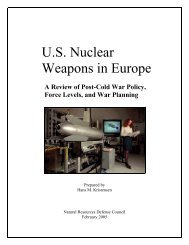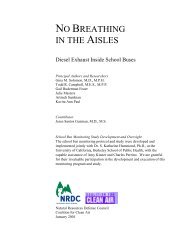p.53-94 (pdf) - Natural Resources Defense Council
p.53-94 (pdf) - Natural Resources Defense Council
p.53-94 (pdf) - Natural Resources Defense Council
Create successful ePaper yourself
Turn your PDF publications into a flip-book with our unique Google optimized e-Paper software.
Appendix C U.S. Nuclear Weapons, Location Profiles, CONTINUED<br />
By November 1951, with the Cold War heating up, the AEC estimated that five plants would be<br />
needed to match the future numbers of warheads that were planned to be built. A third facility was<br />
planned at Spoon River, Illinois. But by 1953 it was decided that two plants would suffice to meet<br />
production goals and plans for the other three were canceled. The Burlington Plant operated until<br />
1975 when its functions were transferred to Pantex<br />
Texas also hosted two of the original National Stockpile Sites (NSS). Killeen Base (“Site B”) at<br />
Fort Hood, Texas, was the first of the initial three (with Manzano Base and Clarksville Base) to<br />
receive weapons, in 1<strong>94</strong>8. The second NSS was Medina Base at Lackland AFB, San Antonio. The<br />
original storage area was constructed between 1953 and 1955. In 1959, the AEC built a Modification<br />
Center at Medina Base for disassembling weapons and storage operations for the military ceased.<br />
On November 13, 1961 an explosion involving 123,000 pounds of chemical high explosive components<br />
of nuclear weapons occurred at Medina. On the southern boundary of the Medina facility workmen<br />
were placing subassemblies from dismantled atomic bombs in a storage igloo. The subassemblies,<br />
which were being stored for further processing and disposal, contained chemical high explosives,<br />
aluminum, natural and depleted uranium. No longer covered by the metal bomb shell, the subassemblies<br />
were being stored in metal and plastic explosive cases which had openings on their surfaces leaving the<br />
explosive exposed. They were handled by a three-man crew—two fork lift operators who moved them<br />
from a straddle carrier into the igloo and one man on the carrier.<br />
Most of the load was in the igloo when at about 10:24 the explosive in one of the subassemblies<br />
ignited. Seeing the flash, the drivers sprinted for cover, alerting the men outside. For about 45<br />
seconds the explosive burned. Then it detonated with a force of over 60 tons of TNT. The first<br />
explosion set off other subassemblies in the igloo and those still on the carrier. The igloo disappeared<br />
in a cloud of smoke and dust, leaving a crater some twenty feet deep.<br />
In the 45 seconds between ignition and detonation the three workers got away. Their injuries<br />
were minor. Adjacent igloos were not disturbed. The shock was felt for miles. Windows were<br />
shattered in downtown San Antonio, twelve miles away. This is one of the 32 acknowledged “Broken<br />
Arrows” or serious nuclear weapon accident confirmed by the Pentagon.<br />
The disassembly/modification work continued at Medina until 1965, when all functions were<br />
transferred to Pantex. At the current 1,300 warhead per year retirement rate, it is estimated that<br />
some 300 to 400 weapons are present at Pantex at any one time. Warheads in the pipeline to be<br />
dismantled are also stored at Kirtland AFB in New Mexico. These include 200 W79s, 1,100 W69<br />
SRAM warheads, and 450 W56 Minuteman II warheads. The last W48 155mm (6-inch) artillery<br />
warheads, W70 Lance warheads, W68 Poseidon warheads, and B57 nuclear depth and strike bombs<br />
have been completely retired.<br />
Over the ten year period from October 1986 through September 1996, Pantex disassembled 12,514<br />
warheads. It has more than enough capacity to disassemble the entire stockpile at current workload<br />
levels and will complete its current work orders in the year 2000. As of the end of 1997 there are<br />
approximately 10,750 “pits” (nuclear cores of warheads that have been dismantled) in storage at<br />
Pantex.<br />
Worldwide Nuclear Deployments 1998 69
















